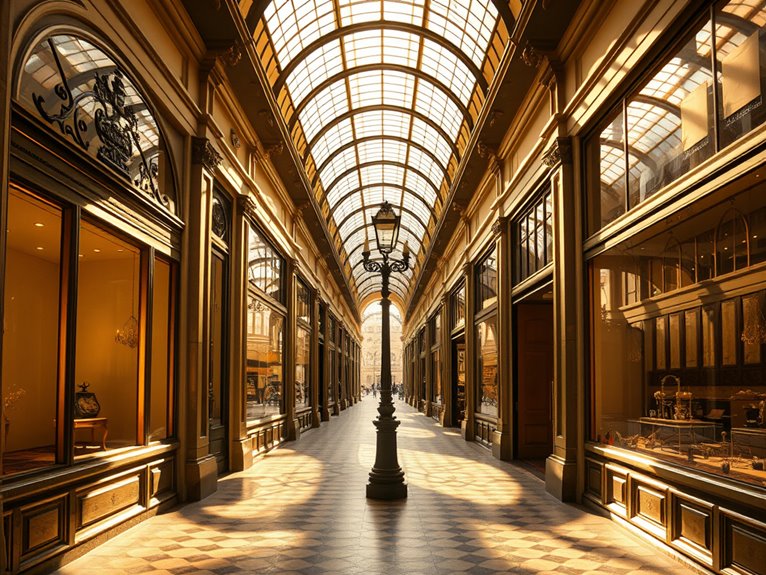
7 Historic Covered Passages in Paris to Explore
Looking to explore Paris's historic covered passages? I'll guide you through seven stunning glass-roofed arcades that revolutionized 19th-century shopping. From the oldest surviving Passage des Panoramas (1799) to the elegant Galerie Vivienne and the exotic Passage Brady, these architectural gems offer unique experiences. Each passage tells its own story through antique shops, traditional restaurants, and artisan workshops. Wait until you discover the secret histories behind these hidden Parisian treasures!
Passage Des Panoramas: the Oldest Surviving Arcade

The Passage des Panoramas stands as a sign of Paris's elegant shopping heritage, holding the distinction of being the city's oldest covered passage still in existence. Opened in 1799, this historic arcade pioneered the concept of sheltered shopping galleries that would later proliferate throughout Europe, offering Parisians protection from rain and mud while they browsed fashionable boutiques.
Walking through its glass-roofed corridor today feels like stepping into a perfectly preserved slice of 19th-century Paris. The passage earned its name from the two rotundas that once displayed panoramic paintings at its entrance, and while these are long gone, the arcade remains a treasure trove of vintage shops, stamp dealers, traditional restaurants, and historic architectural details that transport visitors to the city's golden age.
Quick Facts:
- Operating Hours: 6:00 AM – Midnight (individual shop hours vary)
- Best Time to Visit: Weekday mornings or early afternoons
- Photography: Permitted, but challenging due to lighting conditions
- Access: Free entry
- Location: Between Boulevard Montmartre and Rue Saint-Marc
- Metro: Grands Boulevards (lines 8, 9)
Notable Features:
The mosaic flooring and intricate ironwork dating back to the 1800s make the passage architecturally significant. The original gas lighting fixtures, though now electrified, remain in place, creating an atmospheric ambiance. Insider tip: Visit during the "golden hour" just before sunset when natural light filtering through the glass roof creates stunning photo opportunities.
Shopping Experience:
The passage houses numerous specialty shops, including the famous Stern graveur (established 1834), rare stamp dealers, and vintage postcard merchants. Most businesses operate Tuesday through Saturday, 11:00 AM – 7:00 PM. Hidden gem: The small antiquarian bookshop near the northern entrance often has unique finds not listed in their window display.
Dining Options:
Several historic restaurants line the passage, including L'Arbre à Cannelle and Racines. These establishments maintain their original 19th-century decor, with some featuring authentic period furnishings. Secret tip: Make lunch reservations at Racines to enjoy their daily specials at better prices than dinner service.
Pro Tips:
For the most authentic experience, visit on a rainy day when the passage serves its original purpose as a shelter from inclement weather. The contrast between the wet streets outside and the dry, warm interior creates a magical atmosphere. Photographers should bring cameras capable of handling low-light conditions, as the glass roof and historic lighting create challenging but rewarding shooting conditions.
Practical Advice:
While the passage is technically open early morning until midnight, plan your visit around individual shop hours, typically 11:00 AM – 7:00 PM. Some establishments close for lunch between 1:00 PM and 2:30 PM, and many observe traditional French closing days (usually Sundays and Mondays). Carry cash, as some smaller merchants may not accept cards, and be mindful of the narrow corridors during peak tourist seasons.
Galerie Vivienne: A Masterpiece of Neoclassical Design
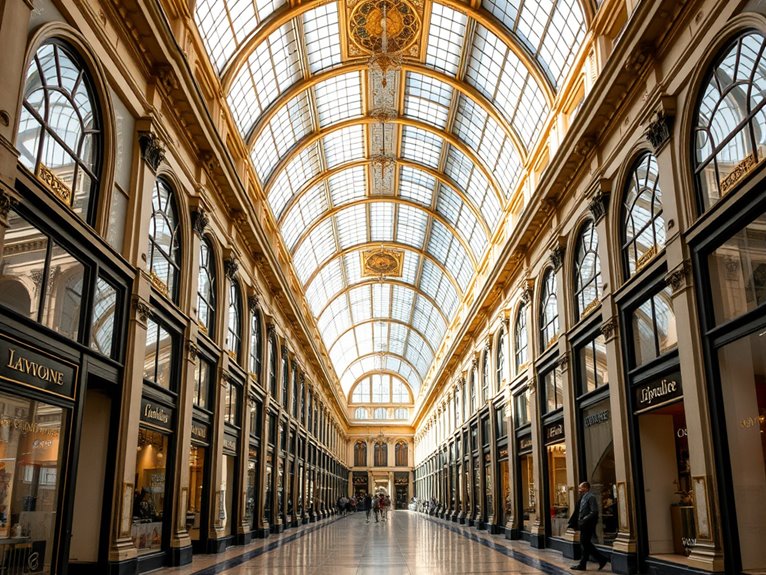
Constructed in 1823, Galerie Vivienne stands as one of Paris's most elegant covered passages, embodying the sophistication and architectural brilliance of the Neoclassical period. This glass-roofed arcade, with its intricate mosaic floors, classical sculptures, and refined boutiques, represents the golden age of Parisian commercial architecture and continues to captivate visitors with its timeless beauty.
Located in the 2nd arrondissement, this historical landmark serves as both a shopping destination and an architectural museum. Its ochre-colored walls, ornate glass ceiling, and perfectly preserved 19th-century details transport visitors to an era when these passages were the height of Parisian luxury and innovation, making it an essential stop for architecture enthusiasts and casual visitors alike.
Quick Facts:
- Opening Hours: Daily 8:30 AM – 8:30 PM
- Best Time to Visit: Weekday mornings for fewer crowds
- Photography: Permitted, best lighting between 11 AM – 2 PM
- Location: 4 Rue des Petits Champs, 75002 Paris
- Nearest Metro: Bourse (Line 3) or Palais Royal-Musée du Louvre (Lines 1, 7)
- Entry: Free
- Shopping: Boutiques typically open Tuesday-Saturday, 11 AM – 7 PM
Architectural Highlights
The passage's most striking feature is its elaborate mosaic floor, featuring geometric patterns and classical motifs that run the entire 176-meter length. The glass and iron ceiling, a marvel of 19th-century engineering, bathes the interior in natural light while protecting visitors from the elements. Insider tip: Look for the zodiac signs incorporated into the ceiling design – a detail often missed by casual observers.
Shopping Experience
The gallery houses an eclectic mix of high-end boutiques, antiquarian bookshops, and vintage clothing stores. Notable establishments include Librairie Jousseaume, operating since 1826, and several designer boutiques. The prices tend toward the luxury end, but window shopping is equally rewarding. Insider tip: Visit during January or July for the traditional French sales period (soldes) when shops offer significant discounts.
Cultural Significance
Galerie Vivienne's literary connections are profound, having been frequented by writers like François Truffaut and Jean Cocteau. Today, it hosts occasional cultural events and exhibitions, particularly during Paris Fashion Week. Insider tip: Check the gallery's seasonal calendar for special evening events when the passage is illuminated and shops stay open late.
Pro Tips:
For the best photography opportunities, visit during early morning hours when the light streams through the glass ceiling at ideal angles. Combine your visit with exploration of nearby passages (Galerie Colbert and Passage des Panoramas) to fully appreciate the variety of Parisian arcade architecture. Consider visiting during winter months when the passage offers a warm, dry haven for shopping and dining while providing excellent natural light for photos.
Practical Advice:
While Galerie Vivienne is a public space, remember that it's also home to working businesses and residents. Maintain a respectful volume, especially when photographing, and be mindful that some shops may close for lunch (typically 1-2 PM). Most establishments accept major credit cards, but carrying some cash is advisable for smaller purchases in older shops. For the fullest experience, allocate at least an hour to explore the passage thoroughly, including time to appreciate the architectural details and browse the unique shops.
Passage Jouffroy: Home to Antique Treasures
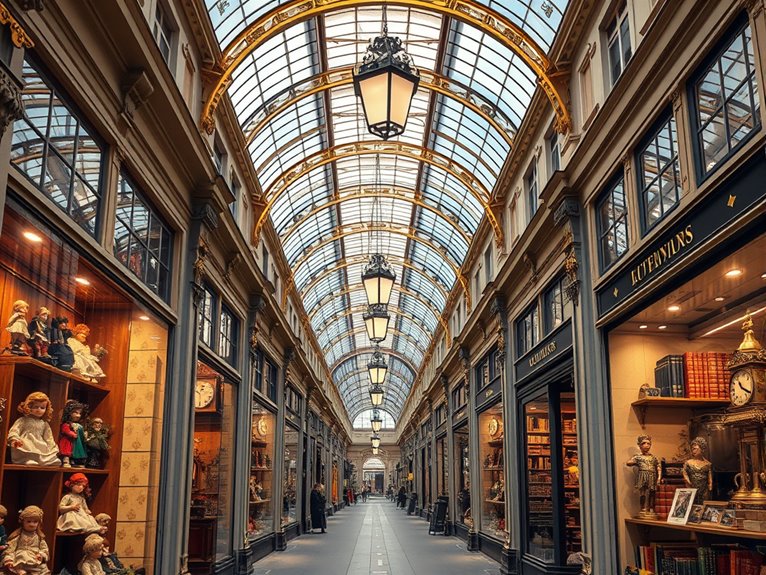
The Passage Jouffroy stands as one of Paris's most enchanting covered passages, drawing visitors into a world where 19th-century charm meets modern collecting culture. Built in 1845, this glass-roofed gallery houses an eclectic mix of antique shops, rare book dealers, and vintage collectibles that make it a treasure hunter's paradise.
Located in the 9th arrondissement, between Boulevards Montmartre and Grands Boulevards, this historic passage has maintained its original character while evolving into a premier destination for antique enthusiasts. Its distinctive black and white marble floors, ornate ironwork, and period details create the perfect backdrop for browsing through centuries of Parisian history and culture.
Quick Facts:
- Opening Hours: 7:30 AM – 9:30 PM (Monday to Saturday)
- Best Time to Visit: Weekday mornings, especially Tuesday-Thursday
- Photography: Allowed, but ask permission in shops
- Payment Methods: Most shops accept cards, but bring cash for better bargaining
- Accessibility: Level entrance, wheelchair accessible
- Climate: Temperature-controlled year-round
Notable Antique Establishments:
La Librarie du Passage
This beloved bookshop specializes in rare editions, vintage postcards, and historic prints. Open since 1850, it offers everything from affordable vintage photographs to museum-quality manuscripts. Insider tip: Visit on Wednesday mornings when new acquisitions are typically displayed.
Le Pain d'Épices
A whimsical toy shop featuring antique dolls, vintage games, and collectible miniatures. The store's original wooden cabinets and display cases are themselves museum pieces. Insider tip: The owner occasionally opens the shop's "secret" storage room to serious collectors by appointment.
Galerie Fayet
Specializing in 19th-century decorative arts, this gallery offers carefully curated pieces from Art Nouveau to Belle Époque. The ever-changing collection includes everything from vintage jewelry to period furniture. Insider tip: Ask about their restoration services, which are among the best in Paris.
Pro Tips:
For the most authentic antiquing experience, visit during the first week of each month when dealers typically refresh their inventory. Build relationships with shop owners by showing genuine interest and knowledge; they often have special pieces not on display. Consider joining one of the passage's quarterly antique walks, where experts share insights about spotting authentic pieces and negotiating prices.
Practical Advice:
Before making significant purchases, research export regulations for antiques from France. Many shops can arrange international shipping, but items over 100 years old may require special permits. Bring a measuring tape and camera (with permission) to document potential purchases, and don't hesitate to request authenticity certificates for valuable items. Most dealers expect some negotiation, but approach it respectfully and be prepared to communicate in basic French for the best experience.
Passage Brady: The Spice Route of Paris
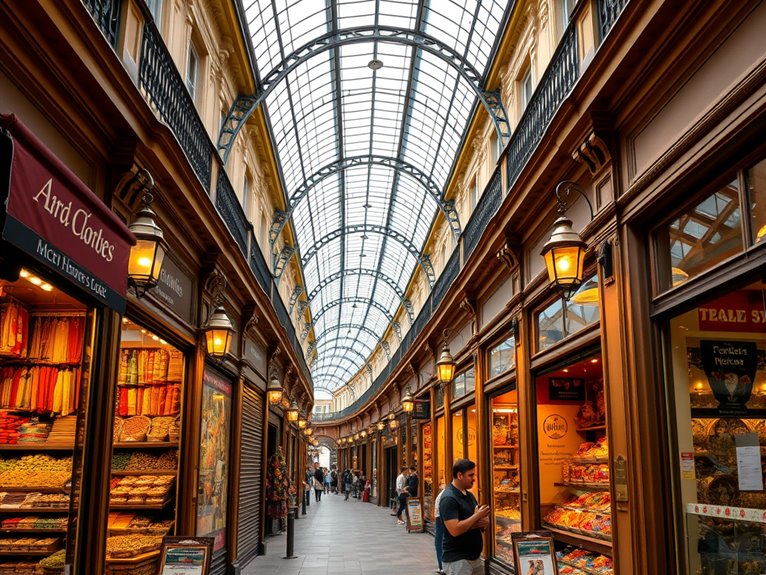
Tucked away in the 10th arrondissement, Passage Brady stands as a vibrant emblem of Paris's multicultural heritage. This historic covered passage, built in 1828, has evolved into the city's "Little India," offering an aromatic journey through South Asian culture, cuisine, and commerce. The glass-roofed arcade houses a remarkable collection of Indian, Pakistani, and Mauritian restaurants, spice shops, and textile merchants.
Walking through the 216-meter passage transports visitors from the bustling streets of Paris to the sensory-rich bazaars of the Indian subcontinent. The ornate iron and glass architecture of the nineteenth century provides a fascinating contrast to the colorful saris, glittering bangles, and towers of spice containers that line the walkway, creating a unique fusion of Parisian elegance and South Asian vibrancy.
Quick Facts:
- Opening Hours: Tuesday-Sunday, 9:30 AM-8:00 PM (most shops)
- Best Time to Visit: Weekday afternoons for fewer crowds
- Photography: Permitted, but ask permission in shops
- Price Range: Budget-friendly (€8-15 for meals)
- Accessibility: Street-level access, narrow passages
- Closest Metro: Strasbourg-Saint-Denis (lines 4, 8, 9)
The Spice Shops
The passage's spice merchants offer an unparalleled selection of South Asian spices, from common curry powders to rare aromatic blends. Notable establishments like Velan and Mumbai Store stock everything from cardamom pods to asafoetida, often at prices considerably lower than regular Parisian markets. Insider tip: Visit between 2-4 PM when shop owners are less busy and more likely to share cooking tips and recipes.
Restaurants and Eateries
Traditional Indian restaurants line both sides of the passage, serving authentic dishes at reasonable prices. Standouts include Krishna Bhavan for vegetarian South Indian cuisine and Passage Brady for North Indian specialties. Most restaurants offer lunch specials under €12, making it an excellent value for Paris. Hidden gem: Several restaurants offer cooking classes by appointment.
Textile and Cultural Shops
Beyond food, Passage Brady houses several shops selling traditional textiles, religious items, and Bollywood movies. These stores provide authentic products at fair prices and often accept special orders for traditional garments. Less known fact: Many shops can arrange for traditional henna application services with advance notice.
Pro Tips:
The best experience comes from visiting during weekday lunch hours when the passage is alive with local office workers and regular patrons. Visit multiple spice shops to compare prices and quality, and don't hesitate to ask for samples. For the most authentic experience, consider joining local workers for the lunch rush between 12:30-2:00 PM, when restaurants serve their freshest dishes.
Practical Advice:
While credit cards are accepted at most establishments, some smaller vendors prefer cash. Bring small bills and coins. The passage can get warm during summer months due to the glass roof, so dress accordingly. Consider bringing a shopping bag, as many of the shops don't provide them. Most importantly, take time to explore both the main passage and its continuation across Boulevard de Strasbourg, as each section offers different specialties and atmospheres.
Passage Du Grand-Cerf: a Haven for Artisans
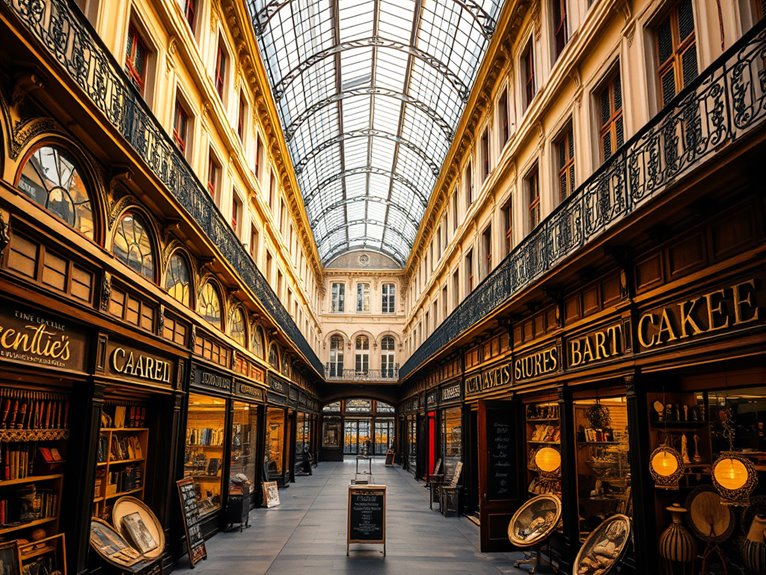
Standing three stories tall with an elegant glass ceiling, Passage du Grand-Cerf represents one of Paris's most stunning covered passages and serves as a vibrant hub for artisanal craftsmanship. This 19th-century arcade, located in the 2nd arrondissement, showcases intricate ironwork, preserved wooden shopfronts, and a remarkable collection of independent artisan workshops.
Beyond its architectural splendor, this passage distinguishes itself as a sanctuary for contemporary craftspeople, housing everything from jewelry designers and textile artists to vintage furniture restorers. The narrow corridor buzzes with creative energy as artisans work in their studios, offering visitors a unique glimpse into Paris's living artistic heritage.
Quick Facts:
- Opening Hours: Tuesday-Saturday, 10:00 AM – 7:00 PM
- Best Time to Visit: Weekday mornings for ideal lighting and fewer crowds
- Photography: Permitted, but ask permission before photographing inside shops
- Payment Methods: Most shops accept cards, but some artisans prefer cash
- Language: Basic French appreciated but not required
- Accessibility: Narrow passage, may be challenging for wheelchairs
Artisanal Highlights:
Jewelry Workshops
Several independent jewelers maintain studios here, creating unique pieces using traditional and contemporary techniques. Visitors can watch artisans at work and purchase one-of-a-kind items. Most workshops offer custom commissions.
Insider tip: Visit during late afternoon when natural light streams through the glass roof, making the metalwork sparkle.
Textile Studios
The passage houses multiple textile artists working with silk, wool, and other natural fibers. These studios often offer workshops and demonstrations.
Insider tip: Some artisans offer private classes if arranged in advance.
Vintage Furniture Restoration
Master craftspeople specializing in furniture restoration maintain workshops where visitors can observe traditional French restoration techniques.
Insider tip: Many restorers welcome questions about their craft and may offer advice on antique care.
Pro Tips:
Time your visit to coincide with the quarterly "Artisans' Open Studios" events, when craftspeople organize demonstrations and special exhibitions. Photography enthusiasts should visit during morning hours when sunlight creates dramatic shadows through the glass ceiling. Consider making appointments with artisans in advance if you're interested in custom work or detailed discussions about their craft.
Practical Advice:
While the passage welcomes visitors, remember it's primarily a working space for artisans. Maintain a respectful atmosphere, avoid blocking walkways while taking photos, and don't hesitate to engage with craftspeople – many speak English and enjoy sharing their passion with interested visitors. Most workshops accept credit cards, but carrying some cash is recommended for smaller purchases or workshop materials.
Passage Verdeau: A Collector's Paradise
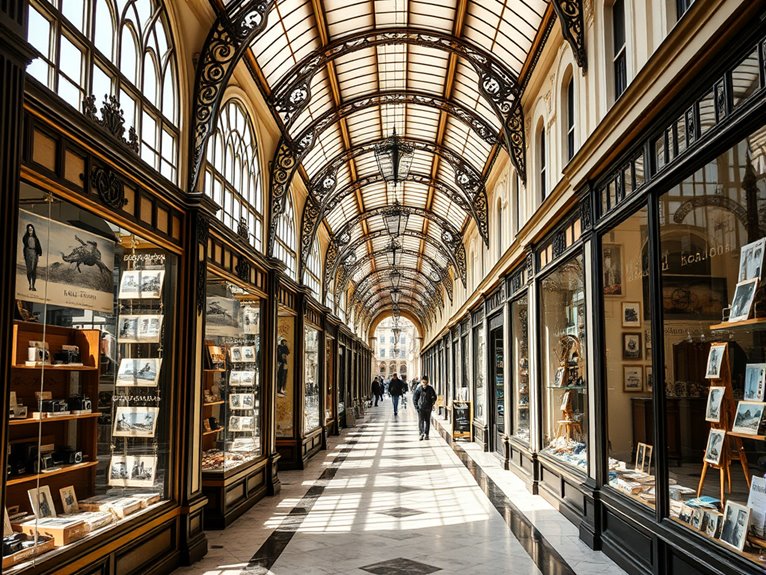
Nestled in the 9th arrondissement of Paris, Passage Verdeau stands as one of the most charming covered passages in the city, particularly renowned for its abundance of antique shops and vintage collectibles. Built in 1847, this elegant glass-roofed arcade maintains much of its original 19th-century character, with ornate iron and glass architecture that transports visitors back to the golden age of Parisian commerce.
For collectors and curiosity seekers, Passage Verdeau represents a treasure trove of antiquarian bookshops, vintage photography stores, and art galleries. The passage's intimate atmosphere, enhanced by its historic lighting fixtures and detailed mosaic flooring, creates the perfect backdrop for discovering unique pieces while experiencing an authentic slice of old Paris.
Quick Facts:
- Opening Hours: Monday to Saturday, 8:30 AM to 8:30 PM
- Best Time to Visit: Weekday mornings for ideal browsing
- Photography: Permitted, natural light best between 11 AM and 2 PM
- Length: 75 meters
- Access: Metro stations Grands Boulevards or Richelieu-Drouot
- Payment Methods: Cash preferred in many shops, major cards accepted in larger establishments
- Price Range: From affordable vintage postcards (€5) to premium antiques (€1000+)
Notable Highlights:
L'Œil de la Photographie
This specialized vintage photography shop offers rare prints, historic cameras, and photography books. The knowledgeable owner frequently rotates the window display with themed collections that reflect important moments in photographic history. Insider tip: Visit on Thursday afternoons when new acquisitions are typically displayed.
Librarie du Passage Verdeau
A haven for bibliophiles, this antiquarian bookstore specializes in art books, first editions, and rare manuscripts. The shop's floor-to-ceiling shelves create an intimate atmosphere perfect for serious collectors. Insider tip: The owner maintains a "secret" collection of rare prints behind the counter – just ask politely to view them.
Pro Tips:
The best deals and most interesting finds typically appear early in the week when dealers return from weekend antique markets with fresh stock. Consider visiting on Tuesday mornings when shops are restocking but tourist crowds are thin. Develop relationships with shopkeepers by showing genuine interest and knowledge in their specialties – they often have additional items not on display and may contact you when special pieces arrive.
Practical Advice:
While browsing, maintain awareness of shop closing times, as many merchants begin closing up 30 minutes before official hours end. Bring cash for better negotiating leverage, especially for smaller purchases. If interested in a notable piece, ask for authentication documents and export information, as some antiques require special permissions to leave France. Most shops can arrange international shipping, but prices and reliability vary greatly between establishments.
Passage Des Princes: the Restored Beauty
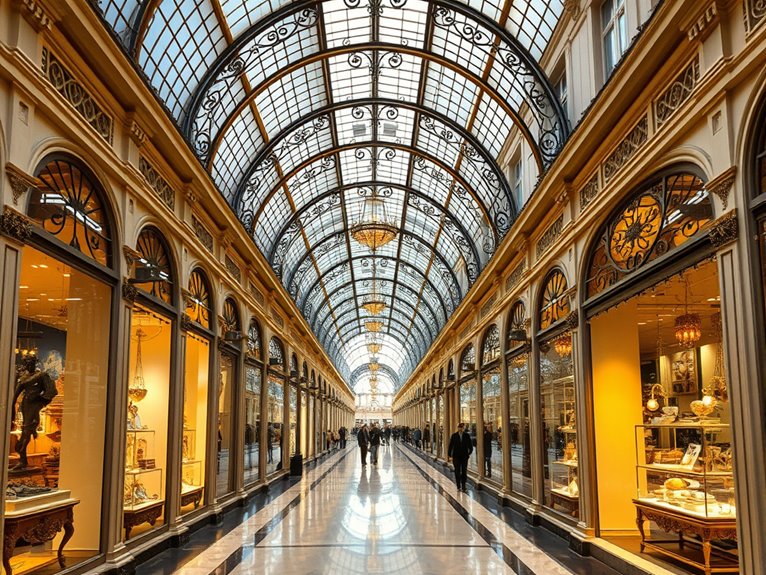
The Passage des Princes stands as a hallmark to Parisian architectural resilience, having been completely reconstructed in 1995 after its original 1860 structure was demolished. This gleaming passage, nestled between Boulevard des Italiens and Rue de Richelieu, represents the modern interpretation of the classic Parisian covered arcade, combining historical elegance with contemporary functionality.
Today's Passage des Princes has emerged as a uniquely specialized shopping gallery, famous for its concentration of toy stores and collectibles shops. The passage's brilliant glass roof, ornate metalwork, and pristine marble floors create an atmosphere that bridges 19th-century charm with modern retail luxury, making it a must-visit destination for both architecture enthusiasts and shopping aficionados.
Quick Facts:
- Opening Hours: Monday to Saturday, 10:00 AM – 7:00 PM
- Best Time to Visit: Weekday mornings for fewer crowds
- Photography: Permitted, best lighting mid-morning
- Location: 5 Boulevard des Italiens, 75002 Paris
- Wheelchair Accessible: Yes
- Notable Features: Glass ceiling, toy stores, historical plaques
The centerpiece of Passage des Princes is its architectural design, featuring a soaring glass and iron roof that bathes the interior in natural light. The passage's modern reconstruction maintains the spirit of the original 1860 design while incorporating contemporary amenities. The marble flooring and elegant shop facades create a sophisticated shopping environment that pays homage to the passage's historical significance.
For shopping enthusiasts, the passage houses several specialized toy stores, including the renowned La Petite Échoppe, which offers an extensive collection of collectible figurines and vintage toys. The shops here specialize in unique items not commonly found in standard retail outlets, making it a treasure trove for collectors and gift-seekers.
The passage also features several historical plaques and architectural elements that tell the story of its past, including original photographs of the 1860 structure. Insider tip: Look for the hidden architectural details near the entrance that survived the demolition and were incorporated into the new structure.
Pro Tips:
The best time to photograph the passage is during mid-morning on weekdays when the natural light streams through the glass ceiling, creating stunning light patterns on the marble floor. Visit during December to experience the passage's magical holiday decorations and special toy displays that transform the arcade into a winter wonderland.
Practical Advice:
While credit cards are widely accepted, some smaller specialty shops may prefer cash payments. Consider visiting the passage as part of a larger covered passage tour, as it's within walking distance of several other famous arcades, including Passage Choiseul and Galerie Vivienne. Street parking is limited, so using public transportation (Metro stations: Richelieu-Drouot or Quatre-Septembre) is recommended.
